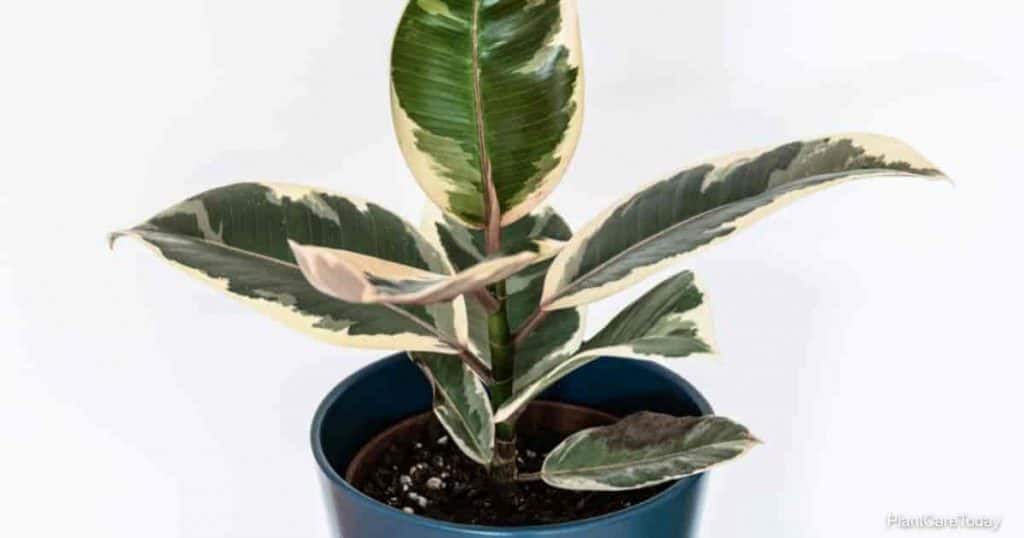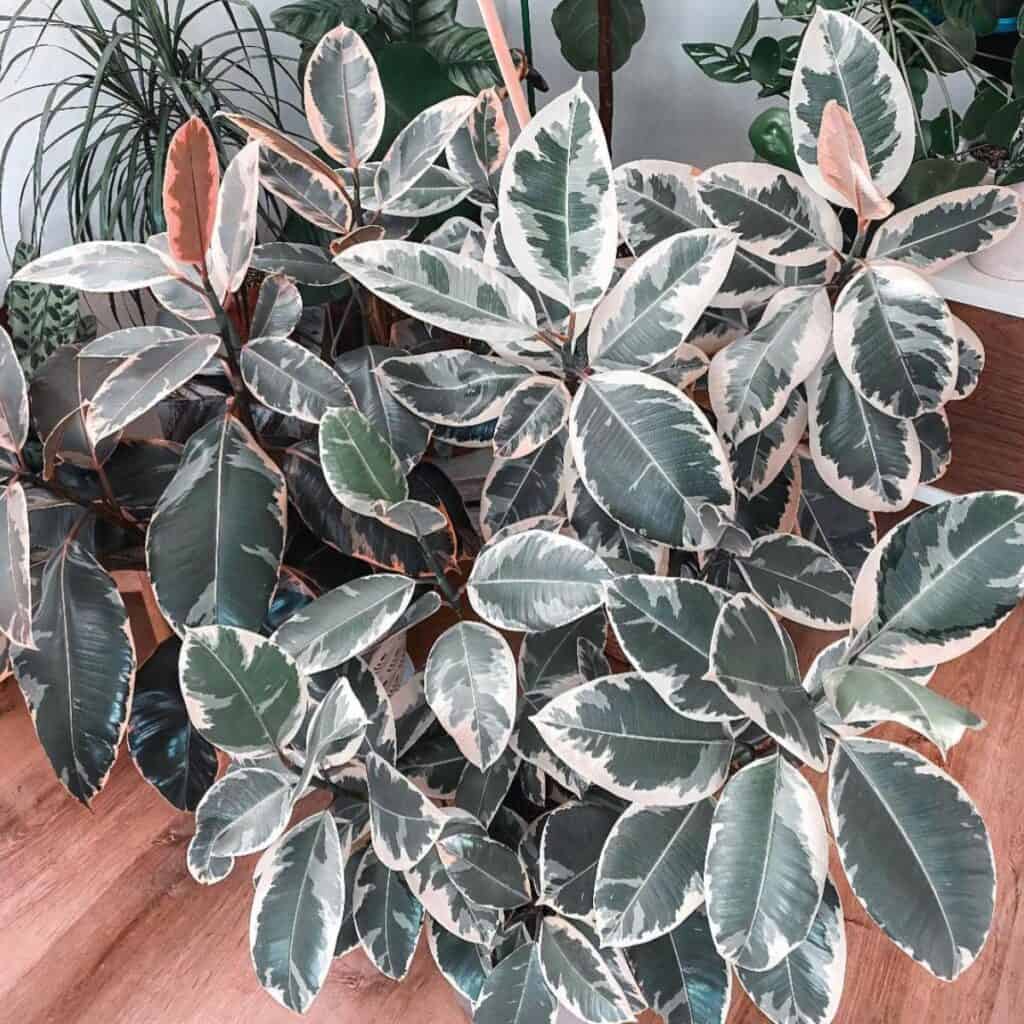What is a Ficus Elastica Tineke? The Tineke is a select variety of Ficus elastica and a “new” highly variegated rubber plant on the market. People love the camouflage foliage pattern.” Below I put together a complete care guide for Ficus Tineke.

Quick Ficus Tineke Care Tips
- Botanical Name: Ficus elastica ‘Tineke
- Common Name(s): Rubber Plant Tineke, Variegated rubber Tree, Tineke rubber plant
- Synonyms: Ficus Tineke, Ficus elastica variegata
- Family & Origin: Moraceae family, native to Southeast Asia, India and Indonesia
- Growability: Easy to grow
- Grow Zone: USDA zones 10-11
- Size: Grows to 2-10′ feet tall indoors and 5′ inches wide
- Flowering: Rarely flowers indoors
- Light: Bright, indirect sunlight
- Humidity: Prefers high humidity
- Temperature: 60-75° degrees Fahrenheit
- Soil: Well-draining soil
- Water: Water when the top inch of soil dries out
- Fertilizer: Diluted liquid fertilizer once a month during growing season
- Pests & Diseases: Mealybugs, spider mites, scale insects, root rot
- Propagation: Stem cuttings and air-layers
- Plant Uses: Air purifier, decorative floor plant
Ficus Elastica Tineke Care- The Basics
Size and Growth Rate
Ficus Teneke grows as a small indoor plant reaching 2′ – 10′ feet tall tree or bush. Growing outdoors in USDA Hardiness Zones 10b to 11, trees can reach 50′ feet tall and more.
Tineke rubber tree displays striking variegation of cream to almost white and green leaves. The mature glossy leaves of Tineke reach up to 12″ inches long and 5″ inches wide. The sheath at the top of the stem is also a deep burgundy-red color. Some suggest the distinctive color of the leaf looks almost like watercolor.
The burgundy rubber tree is a fast-growing Ficus. Variegated Ficus has less chlorophyll and grows at a slower pace.
Flowering and Fragrance
Varieties of ficus elastica’ do flower. But only flower when grown outdoors in their native home of Malaysia, Java, or the Himalayas. Flowering indoors is a rare occurrence. When Ficus elastica tineke does flower, they are simple white blooms.
Its minimal fragrance only attracts fig wasps and no other kinds of pollinators.


Ficus Tineke Light Requirements and Temperature
The ideal Ficus elastica Tineke does best indoors with bright, indirect light. In lower light conditions, new leaves produce less creamy variegation. Plants also are less likely to produce new healthy growth.
- If the leaves are losing their variegation, move your plant to a bright light location.
- Indoors maintain an average room temperature above 55° degrees Fahrenheit. Give Tineke moderate humidity levels with soft morning sunlight. Consider adding a humidifier to increase humidity.
- Remember, too much light can scorch the foliage of Tineke Rubber plants. In contrast, too little light may mean duller colors and less variation from dry heat.
- Ficus Tineke can be finicky to temperature. It does not tolerate inconsistent temperatures. Sudden temperature drops, cold drafts, and wet or dry conditions will affect your plant.
- On the flip side, if your leaves are crispy and have brown spots, your plant may be too dry or get too much sun exposure.


Photo Credit: Instagram / @_thevibespace
How to water and feed Ficus Tinekes: Watering Needs
The popular rubber Tineke is a relatively low-maintenance houseplant. Prevent overwatering rubber plants.
If the roots sit in excess water, they can suffer from root rot, and fungus gnats can become an issue. Allow the top one inch of soil to dry out before watering once every one to two weeks again.
The indoor tinekes still enjoy deep watering according to the natural growing season. Water your plant more during the summer months and scale back during the winter weeks for perfect balance.
Using Fertilizer
Feed your new Ficus species monthly during warm temperatures. Use a half-strength balanced liquid fertilizer.
If you click this link and make a purchase, we earn a commission at no additional cost to you.
Potting, Soil, And Transplanting
The tineke variegated rubber tree plant thrives in light, well-draining, moist soil. It can tolerate heavy clay, sandy, loamy, or dry soil. Remember to use a pot with drainage holes.
When transplanting, pick a pot that’s only a little larger in diameter than the original one. Selecting a pot too big can cause common problems with retaining excessive moisture and soggy roots. Choose a well-draining potting mix. Elastica plants like to be slightly potbound.
It does well in either acidic or alkaline soil. Regardless of the Ficus variety, these plants will grow indoors. Do not overpot. Your Tineke Rubber plant should be fine in the pot it was purchased for a year.
If your plant gets top-heavy, use a cachepot to keep the top-heavy rubber tree from falling over.
Repotting is important to allow the roots to grow continually. Plus, a fresh rich soil mixture will rejuvenate the plant. When repotting, repot during the early spring. Ficus shows shock by dropping leaves.


Tineke Rubber Tree Pruning and Maintenance
As houseplants, the tineke rubber tree will not need much grooming. Mature plants need pruning to maintain their shape or remove unwanted branches.
Pruning the main branches helps achieve a bushier, fuller, and more impressive shape. Using a clean, sharp blade, cut off a six-inch portion of a healthy branch just above a leaf node. For a more slender tree-like appearance, prune rarely.
Large rubber plant leaves collect dust. From time to time, clean the thick, waxy leaves with a damp cloth.
Your potted tropical rubber Tineke tree may grow aerial roots as it gets larger. Outdoors these fast-spreading roots help stabilize the tree but are not necessary. Removing these aerial roots will not damage your plant. When removing them, make a clean, sharp cut.
As for the plant growth, foliage lower on the plant will drop off to focus energy on newer growth. Although some leaf growth is lost naturally, letting your plant get too dry can encourage leaf drop.


Photo Credit: PlantCareToday.com
Propagating Ficus Tineke
Ficus elastica Tineke is easy to propagate. You can start a new rubber tree by air layering. The layering propagation method is not difficult., but does take some practice to get it right.
The process is easy but can get messy due to the milky sap it oozes when cut. But propagating Tineke from stem cuttings makes rooting new variegated rubber plants easy.
- Choose a branch to propagate and take a cutting about 12″ inches long.
- Remove the lower oval leaves.
- Apply a rooting hormone to the base of the tip-cutting.
- Place into a new pot filled with well-draining soil.
- Water and place a plastic bag over the pot to create an artificial greenhouse. A soda bottle works well, too.
- Place your new cutting in a warm location in front of a bright south, east or west-facing window with no direct sunlight.
- New roots should form in 30-60 days.
- Once your new Ficus is well established, repot into a larger 6″ pot.
NOTE: The sap of Tineke Ficus can cause skin irritation
Ficus Tineke Plant Pests or Diseases
The biggest pests challenge for variegated Tineke are leaf and root mealybugs, aphids, plant scales, bugs, weedy thugs, and spider mites.
These “fuzzy white spots” on the Ficus elastica below are mealybugs that suck the life out of many houseplants. We use natural Neem to control them.


Look for Mealybugs on the leaves, stems, and branches of your rubber plant.
If you click this link and make a purchase, we earn a commission at no additional cost to you.
Like other rubber plants, Ficus Tineke is sometimes prone to fungal diseases such as Anthracnose.
All variegated Ficus varieties seem to suffer from some form of brown spots on the leaves. What causes brown spots?
- Too much direct light can burn leaves due to prolonged exposure.
- Low humidity can dry the leaves.
- Over-fertilizing can result in burns from salt buildup.
Ficus Rubber Trees do not like changes. They like:
Consistent Temperatures – When exposed to drops in temperature, they respond by dropping leaves.
Moist Not Wet Soil – If the soil stays too dry and then stays wet. Roots become mushy and start to die. Leaves turn yellow and fall off.
Bright indirect light – Ficus produces leaves based on the tropical light they receive. When the leaves do not “fit” the lighting conditions. The premature leaf drop will be on the leaves.
To keep your Tineke ficus plant looking its best, don’t forget to dust the leaves with a microfiber cloth. For best results, give your Tineke proper care. Don’t forget to turn it on periodically.
Ficus Facts


Where Does Ficus Elastica Originate?
Variegated ficus elastica originates in Southeast Asia, India, and Indonesia.
What family Does Ficus Elastica Belong To?
The easy-to-find elastica cultivar tineke Ficus belongs to the Moraceae family. The plant’s genus name means “edible fig.”





